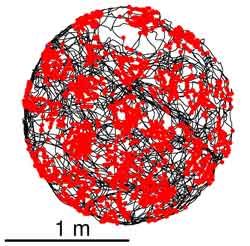The Timing of Nerve Impulses Supports Precise Spatial Navigation

Trajectory (black curved line) of a rat moving in a circular environment, together with the locations where a grid cell discharged (red dots). These locations form a hexagonal grid.<br>© Eric Reifenstein/HU Berlin<br>
Researchers at the Bernstein Centers at HU Berlin and LMU Munich have now shown that this timing code can be reliably read out. Their research focuses on a recently discovered class of nerve cells that become active at specific locations, which are arranged like nodes of a hexagonal grid. In contrast to previous approaches, the researchers consider the neural activity during single runs of the animal, thereby showing that it can use the timing information contained in the neuronal discharge to control and guide its behavior.
To learn how we human beings find our way in the world, neurobiologists have long used rats and mice as model systems. Recently, “grid cells” have been discovered in rodents that actively navigate through their environment. A grid cell fires whenever the rat or mouse is at a node of an imaginary hexagonal grid overlaid on the topography of the outside world. In the past, one commonly assumed that the brain computes the animal’s spatial location from the time-course of the grid cells’ average neural activity, as the timing of individual nerve impulses was believed to be too imprecise. However, researchers at the Bernstein Centers at Humboldt-Universität zu Berlin and Ludwig-Maximilians-Universität München have now shown the opposite to be true: by taking the time sequence of nerve impulses into consideration, one can determine the animal’s position to twice the accuracy than by the number of impulses alone. The timing pattern is clearly evident already in the grid cell’s activity during a single run. “The animal can, therefore, use the precise temporal information to guide its behavior,” says neuroscientist Prof. Andreas Herz, who directed the study.
The discovery of grid cells in the laboratory of Prof. Edvard Moser (Trondheim) in 2004 has captivated many scientists. Not only do average activity patterns of these cells regularly repeat across space, producing hexagonal grids in the spatial map of firing rates, but their temporal patterns of firing are also elaborate. The rhythmic activity on a coarse scale, as measured by the local EEG, organizes and defines the fine temporal structure of the firing in single grid cells: as the animal approaches one of the imaginary nodes of the hexagonal lattice, the cell first becomes active only during the late phase of the EEG oscillation. As the animal continues to move, the nerve impulses shift in time to ever earlier phases.
Until now, this phenomenon was only observed after averaging the data over many runs of the animal, so is the phenomenon biologically relevant or just a side effect of rhythmic activity in this brain area? The new analysis by Reifenstein et al. reveals that the temporal shift in a grid cell’s impulses is not only present on single runs, but the shift is even more pronounced than in data pooled over many runs. Spatial relationships translate into temporal relationships, which can then be used by the brain to refine its representation of space; the level of average activity in grid cells, on the other hand, conveys less information. Such findings could well generalize to other areas in the brain; even if the average activity is maintained at a constant level, neurons can use the dimension of time to encode many different signals and improve the brain’s capacity to process information.
In the course of this study, the researchers reanalyzed data from previous experimental studies from the group of Prof. Moser. Following a modern trend in the neurosciences, the data from this group were made freely available on the Internet, which made further animal experiments unnecessary.
The Bernstein Centers Berlin and Munich form part of the National Bernstein Network for Computational Neuroscience (NNCN). The NNCN was founded by the BMBF with the goal to develop, network, and bundle the knowledge and expertise in the new field of computational neuroscience. The network is named in honor of the German physiologist
Julius Bernstein (1835-1917).
Original Publication:
Reifenstein E T, Kempter R, Schreiber S, Stemmler M B, Herz A V M (2012): Grid Cells in Rat Entorhinal Cortex Encode Physical Space with Independent Firing Fields and Phase Precession at the Single-Trial Level. PNAS, doi: 10.1073/pnas.1109599109
For further information, please contact:
Prof. Dr. Andreas V. M. Herz
Department Biologie II
Ludwig-Maximilians-Universität München
und Bernstein Zentrum für Computational Neuroscience München
Grosshadernerstr. 2
82152 Planegg-Martinsried
Tel: 0049-89-2180-74801
email: herz@bio.lmu.de
Media Contact
All latest news from the category: Life Sciences and Chemistry
Articles and reports from the Life Sciences and chemistry area deal with applied and basic research into modern biology, chemistry and human medicine.
Valuable information can be found on a range of life sciences fields including bacteriology, biochemistry, bionics, bioinformatics, biophysics, biotechnology, genetics, geobotany, human biology, marine biology, microbiology, molecular biology, cellular biology, zoology, bioinorganic chemistry, microchemistry and environmental chemistry.
Newest articles

Security vulnerability in browser interface
… allows computer access via graphics card. Researchers at Graz University of Technology were successful with three different side-channel attacks on graphics cards via the WebGPU browser interface. The attacks…

A closer look at mechanochemistry
Ferdi Schüth and his team at the Max Planck Institut für Kohlenforschung in Mülheim/Germany have been studying the phenomena of mechanochemistry for several years. But what actually happens at the…

Severe Vulnerabilities Discovered in Software to Protect Internet Routing
A research team from the National Research Center for Applied Cybersecurity ATHENE led by Prof. Dr. Haya Schulmann has uncovered 18 vulnerabilities in crucial software components of Resource Public Key…





















